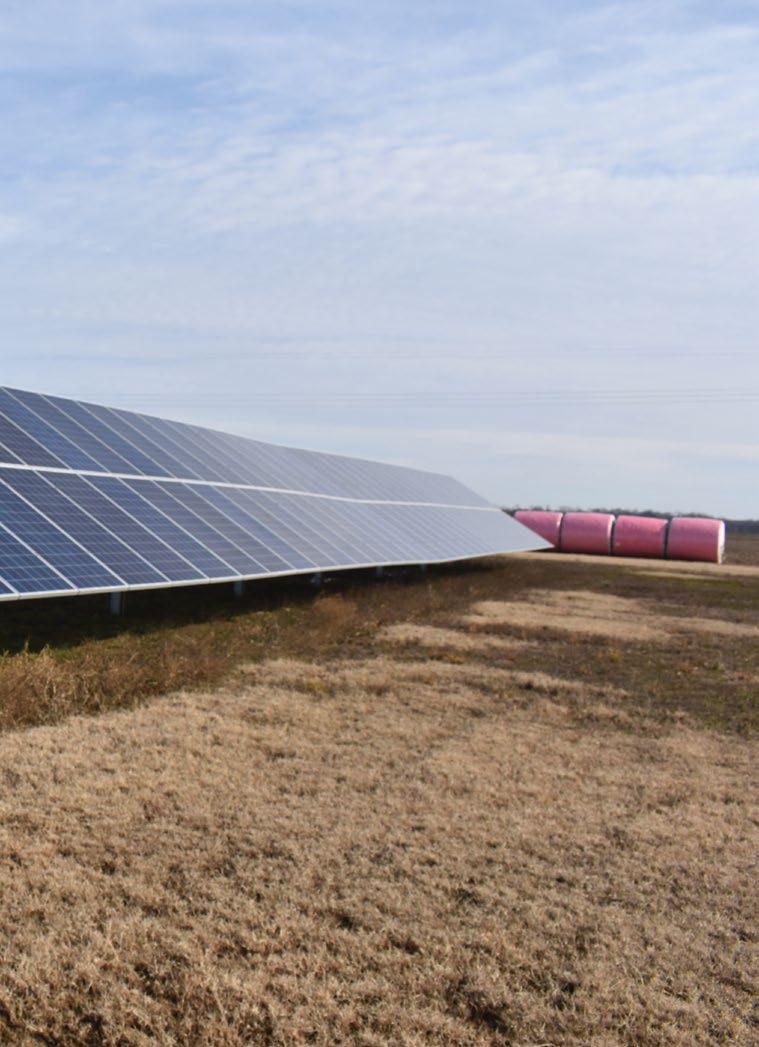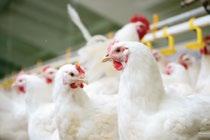
4 minute read
Basking in the Sun
from Arkansas Grown
Arkansas Farmers Harness the Power of Solar Energy
If A.J. Hood had his way, just about every farm in Arkansas would have a barn, some tractors, and a few hundred solar panels. Hood manages Tillar and Company, an expansive row-crop agriculture operation based in the Desha County community of Tillar. The farm was one of Arkansas’s first agricultural adopters of solar energy, and Hood has said to anyone who’ll listen that he hopes for solar “to be as practical on every farm as a tractor” one day. Tillar and Company has an array of more than 600 solar panels harnessing electric power to substantially offset the energy costs typically used to operate the farm’s 300,000-bushel grain facility. The company air dries its rice at that building just after harvest. “We’re always looking to adapt, and in agriculture, if you’re not looking to adapt, you get left behind,” Hood said. “We want to be cutting edge, and we want to be sustainable, and we want to see this farm still all together in 150 years because we were sustainable and good stewards of the environment.” Tillar and Company’s solar system works like this: Using a process called “net metering,” Tillar’s solar array is consistently generating power for which its electric utility is harnessing. In return, Tillar gets credits to use when most beneficial, like in the fall when grain dryers are in full operation. “My system would have to be three times as big to offset my usage if I didn’t have the ability to use net metering to build those credits up in June, July, and August and then use them when I’m drying,” Hood said. “We designed a system based on my needs for that particular grain facility. That’s the beauty of solar. You build to your needs.”
Advertisement
“Solar power is becoming more and more affordable to farmers and to the general public,” said Katie Laning Niebaum, executive director of the Arkansas Advanced Energy Association. “With consumers like Tillar and Company investing in solar energy, the solar industry is one of the state’s fastestgrowing job creators,” Niebaum said. “Upfront costs of solar power have decreased by 50 percent in the last five years,” Niebaum said, “and farmers can benefit from a variety of federal tax incentives.” The U.S. Department of Agriculture offers guaranteed loan financing and grant funding for renewable energy systems for agricultural producers and rural small businesses. The Rural Energy for America Program, or REAP, has money earmarked specifically for solar projects and other funds set aside specifically for Arkansas producers. Hood noted that, for tax purposes, solar equipment is considered a depreciable “We’re always looking to adapt. In agriculture, if you’re not looking to adapt, you get left behind.”

Aside from the incentives, both Niebaum and Hood stressed that solar projects provide some greater financial stability to growers as well.
“Farmers face a great amount of uncertainty in their operations, and now with solar, they have long-term certainty and lower utility bills,” Niebaum said.
Hood put pen to paper to determine just how beneficial a solar array at his grain facility may be, and he quickly learned it was worth the price to eliminate a variable cost.
“We’re taking a variable cost and making it a fixed cost, and in agriculture, that’s extremely important to us. It just takes so much pressure off our operations,” he said. The farm managed by Hood is more than 150 years old, and he said the only way to make it last for the next few generations is through sustainable practices. Tillar and Company is looking for ways to expand its solar footprint, such as through powering its irrigation wells with solar energy.
“Nobody really realizes what producers do on a day-in and day-out basis to see that we are good stewards of the land,” he said. “Whether it’s managing fertility or using surface water, most every farmer is multigenerational and they want to see their kids succeed. Solar falls right into that equation.”


Join a network of
in agriculture. women Connect with other women in ag and grow with educational opportunities. Join our organization and register for our annual conference at arwomeninag.org.
ARKANSAS FARMERS MARKETS
I N A R K A N S A S , M O R E T H A N
More than two-thirds (79%) of all Arkansas counties have an active farmers market, together generating $ 9.2 MILLION in sales in 2017
1,500 FARMERS direct sell at FARMERS markets
79 %

A farmers market is a place where producers from a local area gather to sell their own product directly to the consumer
THERE ARE 111
MARKETS across the state











